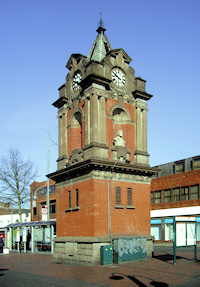Bexleyheath
Bexleyheath, Bexley
The commercial and administrative centre of the borough and a densely built-up suburb, situated to the north-west of Bexley

The hamlet of Upton is of medieval origin and the Crook Log public house is said to date from 1605 but the present-day town centre had nothing but a lone tree and an old windmill until the early 19th century.
Farms on the edge of Bexley Heath (as it was) grazed some cattle and sheep on the scrub, but the presence of highwaymen made the heath notoriously dangerous for Kentish travellers to cross.
The Crayford and Bexley enclosure acts were passed in 1812 and 1814, partly to get rid of squatters who had begun to move here. The first legitimate community began to establish itself soon afterwards. Oak House was one of the earliest and largest homes to be built, around 1817.
By 1831 the settlement had a church and a market, although the population did not rise much above 2,000 for several decades. Upton was still rural when William Morris and Philip Webb built Red House in 1860. Trinity Baptist Chapel (1868) and Christ Church (1872–7) were built towards the western end of the Broadway, and each is handsome in its own way.
Until Bexleyheath station opened in 1895 the settlement was known as Bexley New Town. The station was sited well to the north-west of the town centre because railway director Robert Kersey owned the Brampton Place estate and wanted to profit from its development. Oak House was used as council offices from 1903 and a clock tower was erected in the market square in 1912.
Following the railway’s electrification in 1926 there was a surge in housebuilding and neo-Georgian shops lined the Broadway. New Ideal Homesteads bought and erased Pelham Farm in 1932, allocating a site for Pelham primary school. By 1938 all available land for a mile around had been built on.
From the 1960s, the centre of Bexleyheath was wholly rebuilt. As local historian Malcolm Barr-Hamilton put it, “Only the clock tower has survived the remorseless onslaught of Bexleyheath’s miserable piecemeal redevelopment.” The non-professional Edward Alderton theatre was founded in 1976 on Brampton Road. Oak House was demolished and new civic offices opened in 1980. The Broadway shopping centre was built on the site of Hides department store, the Lord Bexley Arms and Victorian shops that had survived interwar reconstruction.
An Asda supermarket replaced the Bexleyheath Bowl and Regal cinema in 1987 and a larger bowling complex was built on a former playing field and war memorial gardens. In 1989 the Woolwich building society moved from Equitable House, Woolwich, to its new corporate headquarters in Bexleyheath.
Developments in the 1990s included the part-pedestrianisation of the Broadway and the construction of the 126-room Swallow (now Marriott) hotel and the Cineworld multiplex. Broadway Square was completed in 2001.
Following Barclays’ acquistion of the Woolwich building society its Bexleyheath headquarters was closed in 2006. Eight years later the building became the new civic offices for the London Borough of Bexley, replacing four existing premises. The former civic offices on Bexleyheath Broadway were afterwards demolished in preparation for the construction of a Tesco superstore. However, Tesco pulled out of that project in January 2015.
In common with neighbouring areas, Bexleyheath’s population is much less ethnically diverse than London as a whole. At the 2011 census, more than 80 per cent of residents of the Brampton and Christchurch wards were white British.
Bernie Ecclestone and Delia Smith spent most of their childhoods in Bexleyheath.
Kate Bush was born at Bexleyheath maternity hospital in 1958 and grew up in East Wickham.
